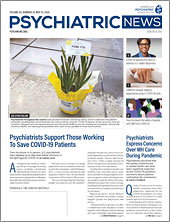Inpatient Care
Who comes into the hospital?
Only hospital staff enter the building. If state law requires it, patients’ attorneys may enter. But there are alternative ways to exercise a patient’s right to see his or her attorney.
No one enters the hospital without answering a screening questionnaire based on guidelines from the Centers for Disease Control and Prevention and having his or her temperature taken. An affirmative answer to any of the screening questions or a temperature above 100.4 F precludes entrance until the staff person gets a negative COVID-19 test result.
All who enter the hospital must do the following:
•
Wear masks throughout the hospital unless alone in his or her own office.
•
Use alcohol-based hand sanitizer at the entrance and repeat sanitizer use or thorough handwashing multiple times a day.
•
Go directly to his or her work area and stay there unless the job requires the person to go to other places in the hospital.
Monitoring patients and patient self-monitoring
Place visual reminders on the units for symptoms to be recognized and reported. Patients frequently forget, misattribute, or ignore symptoms. Remember that some patients do not read English; they should have equal access to the information through pictograms.
Talk to patients during daily/weekly meetings about COVID-19, symptom recognition, and their fears and concerns or lack thereof. Encourage patients to describe their understanding, ask them questions, and educate them about what they miss. This will decrease anxieties, allow otherwise undetected symptoms and concerns to surface, and especially make nurses’ tasks somewhat easier.
Nurses check for symptoms daily. Nurses obtain a full set of vital signs, including measures of temperature, oxygen saturation, respiration, and heart rates daily. They do this two or three times a day if warranted by particular vulnerabilities and if nursing is reasonably well staffed.
Establishing COVID-19 unit(s)
The freestanding psychiatric hospital uses subsections of a larger unit or separate units if the hospital has small units to create (1) an admission unit, (2) a unit for suspected COVID-19 cases, and (3) a unit for confirmed cases. All patients who enter the hospital, including those sent elsewhere for medical emergencies, go to the admission unit and then are transferred to other units as soon as they test negative and it is thought to be safe to do so.
Patients within the hospital who have suspected signs and symptoms of COVID-19 are moved to the suspected-cases unit. If they test negative, they return to the unit from which they came. If they test positive, they move to the confirmed-cases unit. Thus, all confirmed cases are isolated in one area of the hospital. Patients must remain in their own rooms on these units. The hospital must have the capacity to lock patients in their rooms if necessary, even if the hospital would never do so under ordinary circumstances. This includes ensuring rooms do not have blind spots that could be missed by staff conducting safety checks and informing patients ahead of time (and repeatedly as needed) of those measures to minimize negative affects and reactions to “more confinement.”
Be prepared that asymptomatic spread may happen on any unit, turning it into a seed for the virus and potentially a self-designated COVID-19 unit. Keeping both staff and patients informed and equipped is essential to avoid reactive measures and further surprises.
All staff who work on the COVID units do not work anywhere else in the hospital. Staff from other units never float or do overtime on these units. If there is a code, staff from other units do not go to these units; the units must be staffed to meet their own code needs. Staff enter the building at the closest entrance to the unit where they work and go directly to the unit; they stay on that unit for their entire shift. If a nearby breakroom is not used by anyone else, staff can go there. The hospital provides meals to the staff on the unit. Staff who need nicotine replacement should obtain gum, lozenge, or patch as off-unit smoking breaks should be eliminated. Staff leave the building at the end of the workday by going directly out of the building.
If the hospital does not have enough psychiatrists or nonpsychiatric physicians to devote them solely to one unit, these individuals must have head-to-toe personal protective equipment so as not to spread COVID-19 throughout the hospital. Hospitals that have the ability to split their psychiatric and other medical staffing should resort to a rotating part-time off-site work schedule. They should improve use of VPNs, shared calendars, and remote communications.
What staff is on a unit?
Nursing staff must be on units to manage patients. The other clinical disciplines have some discretion. These professionals need a schedule designating who is at an in-person meeting and who is there by other means. If a discipline has more than one member on a unit, the members should be rotated. This should allow those in the room to be sitting six feet apart, including when the patient is present. Patients are informed who is participating remotely even if the patient cannot see staff’s images.
Teleconferencing and videoconferencing
Technology can provide a wide set of players equal access to patients, but this requires—at least at the front end—significant coordination and mastery of devices that many staff may have never used. The hospital gives each unit a dedicated tablet with a videoconferencing account. Attorneys, outside evaluators, family members, and friends can connect remotely (by appointment only) to speak with patients after obtaining the account link for the unit.
Psychiatrists and other team members should also be accessible remotely—whether working on-site or off-site—especially since they are less present on the units than they usually are, leaving a higher burden on nursing staff to manage patients.
Interpreters
Psychiatric assessments are particularly reliant on proper communication, more so than other medical specialties. Patients with Low English Proficiency (LEP) may be at a further disadvantage if not provided with the appropriate language assistance, especially during those times of rapidly evolving news and recommendations. If interpreters are not considered essential enough to be allowed in-person access to the hospital, videoconferencing (even more than telephonic interpreting) should be accommodated whenever possible. Interpreters not only communicate verbal messages between languages, but also visual cues that may be culturally bound and that culture-discordant health professionals may misinterpret or miss. Deaf patients must have interpreters in the room.
COVID-19 testing of all patients in a free-standing psychiatric hospital
In the case of a public psychiatric hospital, the state Executive Office of Health and Human Services sends members of the National Guard in hazmat suits to test all patients in a single day. This was successfully done in one state hospital with 250 patients.
At unit-based, group, or individual meetings, patients are informed the test will be done by swabbing through the inside of the nose with a long cotton swab—a small amount of cotton attached to a stick. Patients are given notice that the test may be uncomfortable but will not cause harm.
Patients are told that the test results don’t all come at once and that it is not significant whether their results come sooner or later. Staff tell patients they will learn the results when they become available.
For those patients who have guardians, guardians are notified before the testing. This is a notification contact, not a contact requesting authorization to do the test. Messages are left if the guardian is not reached.
Patients are asked to agree to the testing and are told staff want to know whether each patient needs more medical help because they test positive. Patients are informed, prior to testing, that those who refuse the testing will be sent to the COVID-19 unit and quarantined for 14 days. Their accepting of the test is voluntary, and they can reconsider their choice either way. This model can be used at VA hospitals, private hospitals, and psychiatric units in general hospitals with variations as to who does the initial testing.
Informing inpatients what they can do to further decrease risk
Patients are told to spend more time in their bedrooms. This has to be explained to each patient, providing as much explanation as each patient can comprehend. For weeks, months, or years, patients have been told not to stay in their rooms and isolate. Now patients are being told exactly the opposite. Group attendance and milieu activities that used to be one measure of patients’ engagement in treatment are now canceled to avoid patient and staff gatherings. That can be confusing as well.
Masks are provided to all patients. Each mask is labeled with the patient’s name. Patients are told how to store their mask when they are in their room (if they have a single room). Each patient is given a paper bag with his or her name on it, and the bag is stored in the same location in every room. Patients are told to wear their own mask only and absolutely not to trade or share masks.
Patients are told to handle the mask by the ear loops because the front or back may be contaminated. Patients are told when they receive the mask to keep their hands away from their face and to wash their hands after taking off their mask (this is only possible in hospitals where patients have bathrooms connected to the bedroom).
The masks can be purchased, but they can also be made. In one hospital, the rehabilitation staff took the lead on making masks of different materials (see photos). Special masks, using short pieces of cloth, are made for patients whose risk assessment indicates they would be a suicide risk.
When masks are distributed by the nurse, the nurse reminds each patient of risk-mitigation efforts that the patients have heard again and again since precautions began—those related to social distancing, hand washing, and the proper way to cough.
Suicide and self-injury
Greater vigilance needs to guide the care and treatment of patients thought to be at risk for suicide in the hospital and even some patients not usually thought to be at risk. Hospital-wide restrictive measures can further impact some inpatients whose world may now be limited to a room. Confinement, lack of agency and helplessness, anxiety, poor sleep, insecurity, and isolation are all COVID-imposed suicide risk factors. Keep a closer watch. Talk about it.
As usual, the psychiatrist and nurse decide whether to put a patient at a higher level of observation for suicide risk. The COVID-19 precautions introduce a new environmental risk factor—the availability of other patients’ masks.
Transforming what are usually group activities into solitary activities
Classes, rehabilitation groups, and leisure groups are suspended. In their place, staff who ran groups have schedules to meet with patients individually.
Meals eaten in dining rooms are replaced with meals eaten in scattered areas or even in patients’ rooms. Since it is likely patients have been told again and again not to eat in their rooms, they need to be told doing so is an emergency measure and not a change in hospital policy. Patients at risk for dysphagia should be identified and allowed to eat only in an open area with staff supervision to minimize risk of choking.
Large groups are no longer allowed in outdoor spaces. Schedules are coordinated so that small groups may use these spaces for recreation or other purposes. Each time a small group goes outside, the patients are reminded about staying six feet apart. Equipment, like a basketball, that would be handled by multiple patients cannot be used.
Staff burnout
Staff burnout needs to be recognized as a risk factor for the spread of COVID-19 as well as for bad outcomes from myriad other sources, like the psychiatrist’s missing a patient’s change in symptoms or a nurse incorrectly administering a medication. Nursing staff are particularly burdened by the added duties with which they are tasked during this pandemic. Sometimes understaffed, often working longer shifts, largely unable to use vacation and personal time, nurses and mental health aides are the frontline workforce on psychiatric units. The nurses are now expected to check vital signs more frequently, keep educating patients on-the-go about safety and hygiene measures, coordinate meetings and appointments requiring the use of teleconferencing, and operate the dedicated tablet for remote encounters to take place. They, and the mental health aides they supervise, are the first to receive and handle patients’ anxiety, anger, need for extra support, and refusal to cooperate. Nurses, and especially mental health aides, respond to patients’ potential and actual violence, which may increase with all patients in such close quarters. For their safety and that of patients, nurses are strictly confined to their unit throughout their shift, and they may not always be updated in a timely fashion about hospital policies before they are asked to implement them and accommodate their practices to them. As flexible, healthy, and well-adjusted as they may be, nurses now face the same insecurity and powerlessness as our patients while carrying more risk than team members on the front line.
What is the role of the psychiatrist? Start with what we do best: supportive listening. Step in where we can to help, even if it’s usually the nurse’s or the mental health aide’s job. Educate and share information about new developments in the hospital and in the field. Use the flexing of HIPAA restrictions to share information that may save lives. Feed the staff. Bring in individually wrapped candy or other goodies and casually leave them in the nursing station. Ask a nurse or aide how his or her family members are doing. If you know, tell them where to buy toilet paper!
Downstream of COVID-19, the surge of mental health needs for people with SMI and those with less severe mental illness will increase. Having mentally healthy and capable staff ready to continue providing psychiatric care is more crucial than ever.
Community Residential
Group living environments (GLE)
Residents are not permitted to leave the residence and its property. If the residence has grounds, then residents can exercise on those grounds.
Residents cannot congregate in common areas of the residence.
The number of residents allowed in the kitchen, living room, and other common areas at one time is designated with signage on the walls for each area.
Residents do not eat meals sitting together at one table. They eat in shifts or spread throughout the common areas of the house. Food shopping is done online.
Prescriptions are delivered if possible. If not, staff pick up prescriptions at the end of a workday and bring them to the GLE the next morning when they come to work.
No matter how many sinks and toilets are in a bathroom, only one resident uses the bathroom at a time. All residents must keep all toiletries in their own room.
Staff and residents develop learning objectives for each resident that involve online tasks, reading, artwork, puzzles, word games, or any activity that one can do on one’s own. If the GLE has a yard, these tasks can involve outdoor, solo activities.
All appointments with primary care providers, psychiatrists, and therapists are done virtually. This should be no hardship as most of these appointments are being done virtually in all sectors—except that they may require further staff involvement and assistance for people with SMI.
One exception to consider involves residents who work in health care settings—or other truly essential jobs—where they are needed on-site. GLE staff should do their utmost to accommodate these individuals by establishing a way for them to go to work and to be isolated at all times from all other residents when they are in the house. If this is not possible, staff should look into alternative temporary living situations for these residents.
Independent living
People with SMI living independently or with various forms of support, such as Programs of Assertive Community Treatment (PACT), intensive case management, or cluster apartments pose a tremendous challenge.
Long before the COVID-19 pandemic, many people with SMI were struggling with isolation and loneliness; this problem is now amplified. After years of being taught skills and encouraged not to isolate, all of a sudden the same staff are saying, “Stay home. Don’t go out. Don’t get closer than six feet to anyone.” Outreach workers who have shown up reliably for face-to-face meetings don’t come anymore. The psychiatrist these individuals have seen every month, perhaps for decades, is only a voice on the phone. People with SMI who worked so hard to be able to enter a supermarket and shop on their own are told to stay home and order online. The ritualistic cup of coffee at the corner diner can’t happen because the diner is shut down.
To avoid two bad outcomes—significant increase in psychiatric symptoms due to increased isolation and enduring the risk of COVID-19 infection because being trapped in a room or an apartment alone is just too hard to do—PACT staff, outreach workers, and outpatient therapists must increase (not decrease) contact. Have virtual meetings, more frequent phone contact with those who don’t have a computer, and use more “brief” check-ins. Depending on the level of restrictions and the safety of being outside in one’s area, while staying at least six feet apart, meet the person with SMI in a park, take a walk together, go together to the ATM machine, go on a local hike in the woods, take a bike ride, and so forth.
Clubhouses have set up virtual events and call-in lines. Some drop-in centers and peer-run services have reconfigured themselves into virtual services. Hotlines are geared up for more calls.
The essence of these interventions is to help people with SMI not feel alone and not feel scared.



